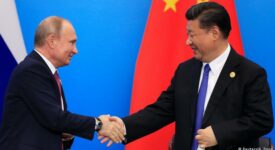The European debt crisis is destined to be an epoch-making event, not just for Europe, but also for Europe’s major partners, including the United States and China. Its impact is so profound that the EU, the US and China all have to recalculate, re-position and transform their internal and external strategies to adapt themselves to a fast-changing and largely uncertain future, a future shaped not by Europe’s strength, but by its possible absence. The US and China are “locked” in a new triangular relationship, with Europe as the pivot, weakened, but still influential and of strategic relevance.
Europe as a Strategic Balancer?
Europe is endowed with a unique position between America and China. If China and the US stand at the two ends of a spectrum, Europe has at least four choices: standing side by side with the US, with China or standing center-left or center-right. So far, we haven’t seen Europe taking sides in a clear-cut manner. Europe keeps a delicate balance between the US and China, despite a moderate preference for the US. It is worth mentioning that Europe’s America-leaning preference has long given Chinese Euro-skeptics ammunition that Europe “colludes” with the US against China, or Europe is simply too weak to make a difference in the China-US relationship. The Euro debt crisis is confronting Europe with a big question – where to stand and what to do to face a new round of power reconfiguration as a result of its debt crisis.
US-EU Trade Coalition against China?
On the trade front, there is, however, an increasing tendency for the US and the EU to form an alliance against China. The typical example is the newly launched Transatlantic Trade and Investment Partnership between the EU and the US (TTIP). According to a study conducted by Wuhan University Centre for Economic Diplomacy, the value of Chinese exports affected by the trade diversion effects of TTIP would be altogether 200 billion Euros. Even the actual trade diversion were only 10%, the total value would be as high as 20 billion Euros, roughly 1% of China’s total exports and 0.3% of China’s GDP.
The EU has tended to work together with the US, driven by both sense and sensibility. On the one hand, the US and the EU have had some common interests such as opening China’s government procurement markets, protecting intellectual property rights and safeguarding a stable supply of raw materials. On the other hand, the EU arguably felt somewhat unprepared facing China’s rapid rise and its seismic impact on the world market and supply chain. The memory is still fresh of when China used to be a GSP and aid recipient several years ago. That sensibility is even more apparent in the hard times Europe is now going through. With both interest incentives and bitter sentiments, the EU might easily be tempted to accept the American invitation to establish an international coalition for creating and enforcing trade rules, grabbing China’s fat public procurement market and launching more trade defense investigations or WTO lawsuits. That coalition may change the relative power relationship on trade issues in this triangular relationship, but could also result in a backlash. To that end, China’s Euro-skeptics continue to doubt the EU’s willingness to establish a true strategic partnership with China.
Constructing a New Model of Great Power Relationships
China newly proposed the idea of constructing a new model of partnership with Europe, as it is now doing with the US. China wants to build the Sino-EU relationship as a good model for a bilateral relationship in the 21st century, going beyond the differences in political and social systems. China is also trying to establish a new type of great power relationship with the US, different from traditional type of power rivalry. But still, the ideological divide and the logic of history of great power clashes remain an obstacle in relationships. The more they develop relationships, the more they feel it necessary and urgent to strengthen mutual trust. China has come up with the proposal to establish “strategic mutual trust” with the US and the EU, by means of which China would like European and American leaders and policy-makers to think at an equally high strategic level.
“Strategic trust” is different from value-based trust. The former requires the vision of a strategist. Many Chinese diplomats and high-ranking officials are trained as strategists from a very early period of their career. It requires both sides to start from a realistic perception of each other’s primary interest and tackle the major aspect of a problem, and the source of tensions. The latter requires long-term cultural and value convergence. It needs several generations to be fostered. Certainly, the EU-China and the US-China relationships, young in their thirties, are not yet ready for that. Therefore, a realistic path for China and western countries to dilute estrangement could be a two-step process – firstly, cultivating strategic trust and secondly, fostering shared values. To achieve that, more cultural exchanges are needed. China needs experts on Europe and the US, just as they need more experts on China.







